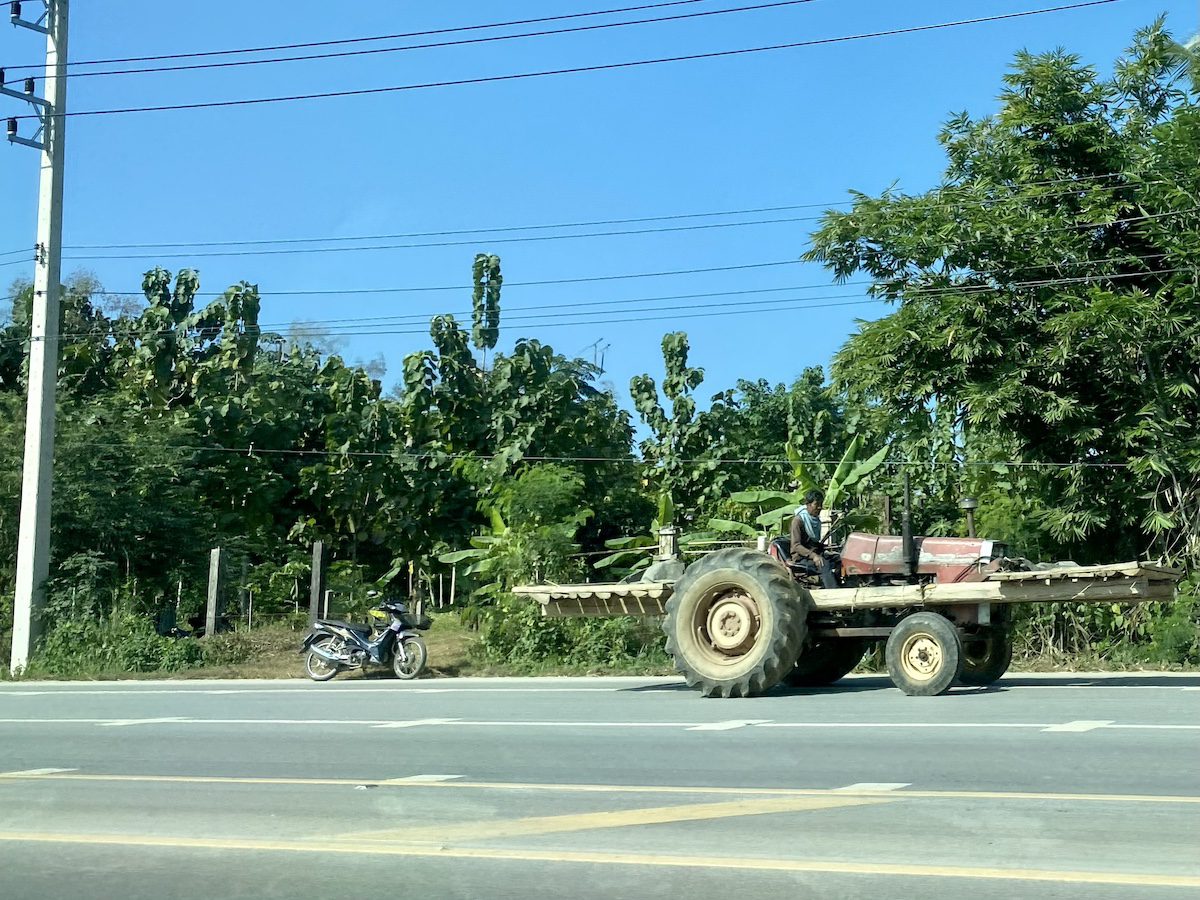Driving in Thailand, Vietnam or Laos is totally different to driving in a western country.
We travelled to all three countries and were blown away by the traffic mayhem!
At first, it’s overwhelming… dangerous, chaotic, and unpredictable. But after a while, we saw patterns and logic in why the locals drive like they do.
We travelled many roads in Vietnam, Laos, and Thailand, including two weeks of driving in Thailand in a rental car. There’s no better way to experience the wonders of the northern Thailand mountains than having your own wheels.
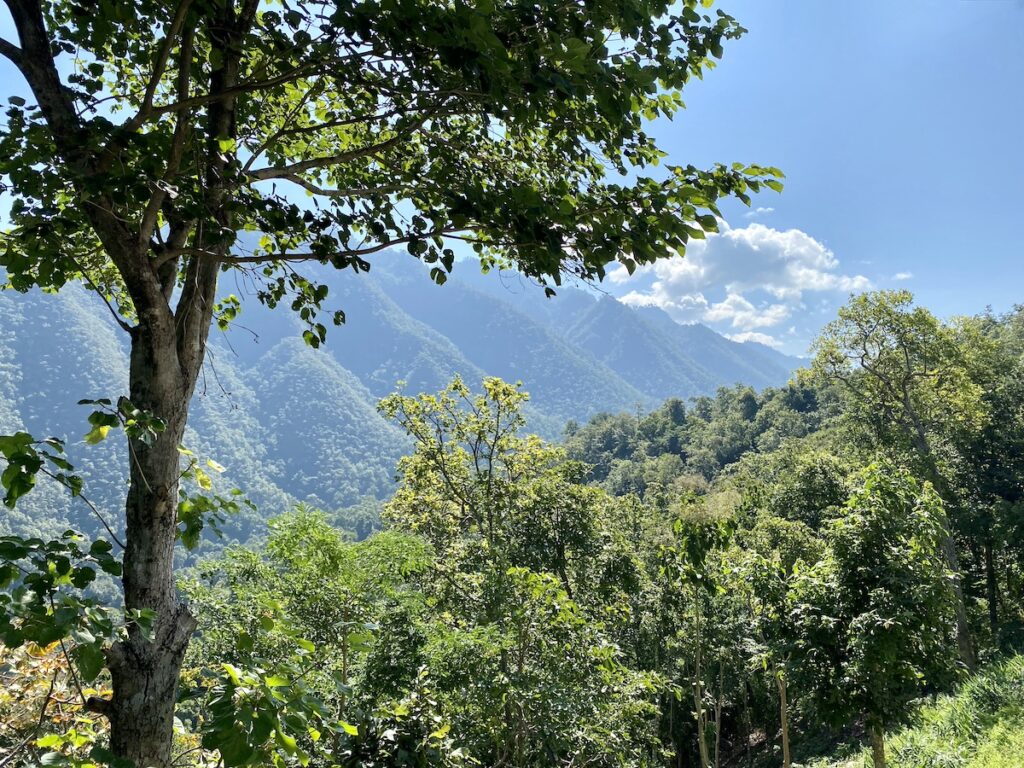
As an Australian, the contrast between driving here and driving in South-East Asia is extreme. We drive on endless country roads, isolated outback roads, and into remote places.
But we also live close to Sydney. So congestion and dealing with aggressive drivers is something we’re used to.
However, driving in South-East Asia is different, totally different.
Thai, Lao, and Vietnamese drivers aren’t necessarily worse or better drivers than we are. They’re exactly like us – if the traffic police don’t enforce it, then you can get away with it. This seems to be a universal rule!
Driving Is Crazy!
At first, we couldn’t believe the chaos. But it soon starts making sense… and somehow seems to work. You know you’ve been in SE Asia too long when you no longer notice a tractor driving the wrong way down a four lane freeway!
Common Traits In Thailand, Vietnam, And Laos
Vietnam, Laos, and Thailand drivers have a few common traits. The first one? If you can take a shortcut, then do it! If this means driving or riding the wrong way down a freeway in the breakdown lane, then so be it.
Or using the breakdown lane to form another lane at the traffic lights.
Or ignoring traffic lights completely, like turning left through a red light or driving through a red light when there’s no other traffic.
Or spreading across the entire road at a level crossing on both sides of the tracks. So you get this wall of cars and bikes facing each other off across the tracks.
It takes at least 5 minutes for the mess to untangle itself once the boom gates open!
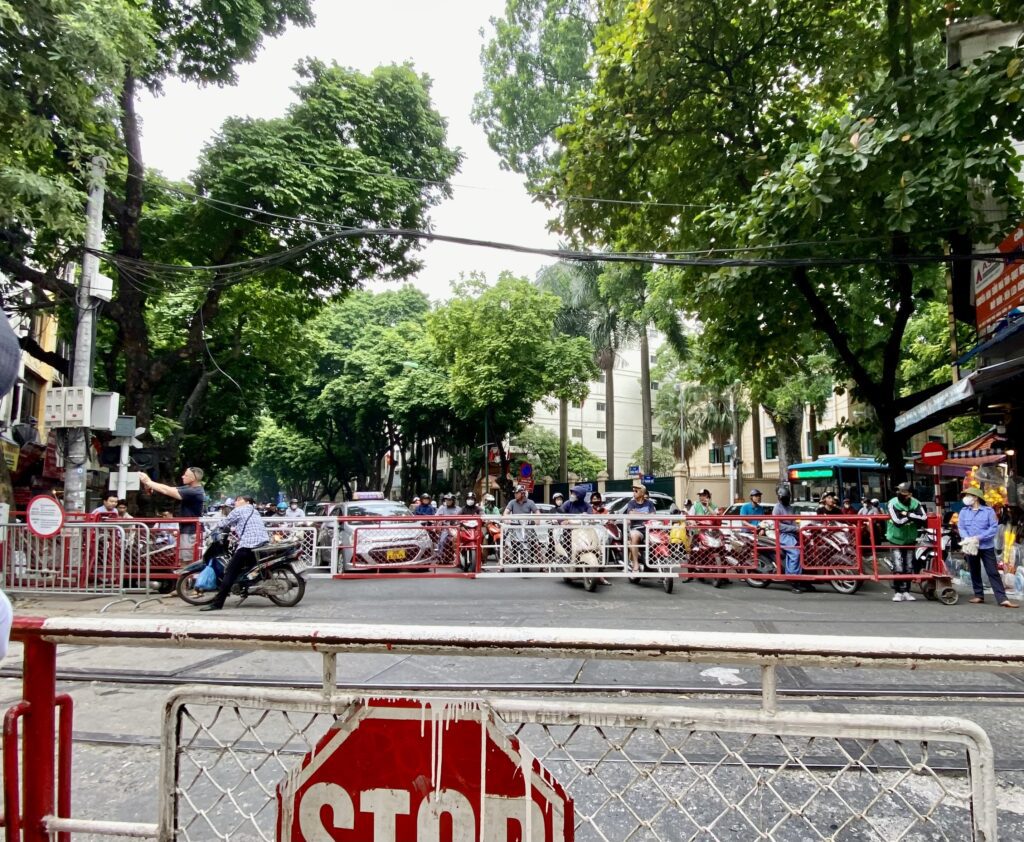
Or cutting inside another vehicle when you turn into a road. As in, turning into a side street by driving past the passenger’s side of a waiting vehicle.
The second common trait? Everyone uses the road – not just cars and trucks.
Think:
- kids on motorbikes riding to/from school (and doubling at least two mates!),
- entire families on one scooter,
- tractors,
- farm trucks,
- electric scooters,
- motorbikes with homemade sidecars carrying multiple people,
- people walking (including small kids beside busy roads),
- vendors selling food,
- and so on.
It could be a back road in a village or a multi-lane highway… it doesn’t make any difference.
I love the idea of the road being there for everyone, to a point. Although, allowing young kids to ride motorbikes on main roads is an obvious recipe for disaster.
Unfortunately, sharing roads is a concept we’ve lost. Australian drivers tend to treat the roads like our own personal domain.
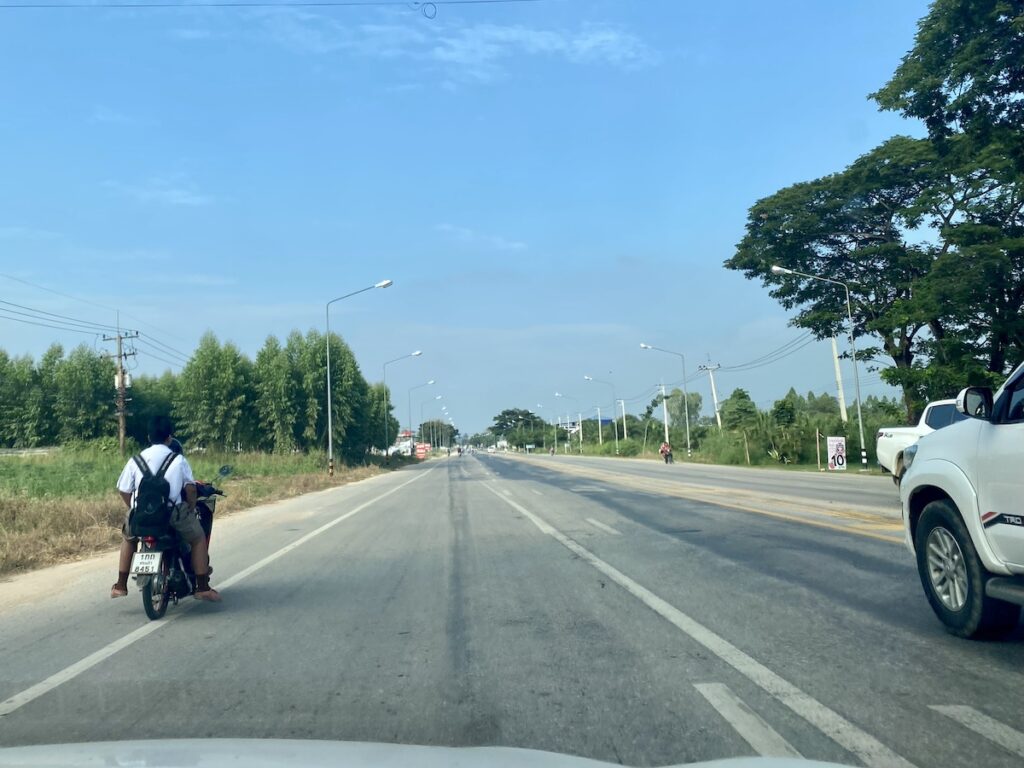
The thirdly trait is perhaps the most important – patience. Without patience, there’d be carnage.
If the driver in front decides to completely stop on the freeway before they turn into a driveway (which they do often), then so be it. Or if someone does a U-turn in an already heavily congested city street, that’s fine.
The fourth trait is downright dangerous. If you’ve ever followed someone using their mobile phone while driving, you’ll know what I mean. Everyone uses their mobile phone while driving or riding… everyone.
The most extreme example we saw was a Grab Eats (like Uber Eats) rider on a heavily congested freeway. He overtook us on the inside, doing well over 100km/h, one hand holding a phone and texting. Insane!
Finally, expect the unexpected.
Like a road crew in the mountains… sitting on the road, around a blind corner on a steep downhill descent, sitting in front of their vehicle for “protection”. What could possibly go wrong!
Yes, the roads are crazy and dangerous. And when things go wrong, they go spectacularly wrong.
The road tolls in Thailand and Laos are grim:
- Thailand’s road toll sits around 15,000 – 20,000 per year. That’s around 20 deaths per hundred thousand people.
- Laos’ road toll is around 1,000 per year, or about 13 deaths per hundred thousand people.
- Vietnam’s road toll is about 6,000 per year, or roughly 7 deaths per hundred thousand people.
For reference, Australia’s toll sits at less than 5 per hundred thousand.
Vietnam is the outlier here. And there are good reasons why their road toll is so much lower – lower speeds, patience, more awareness of what’s around them, and helmet use on motorbikes. In short, they’re good drivers.
Despite the grim stats, it mostly works. And each country has their quirks.
3 Countries, 3 Different Driving Styles
Vietnamese constantly toot their horns to warn each other they’re approaching. In busy cities like Hanoi though it becomes kind of pointless, with a constant wall of noise.
Vietnamese also drive slowly, making them easier to spot and easier to react to.
Lao people don’t toot because it’s seen to be rude. And if you’re rude, you’ll lose face.
That’s a big problem when a car’s an inch off the back wheel of a motorbike on a highway! Laos drivers take first prize for tailgating – although it’s a close-run contest between the 3 countries. And Laos roads are atrocious, with highways having big sections of broken up tar and huge holes.
Thailand is where we drove for 2 weeks, mainly around wild mountain roads in the north. The roads are excellent, however they drive fast… and drift across the road.
It’s nothing to come around a blind bend to find an approaching vehicle totally in your lane.
Thais also overtake in impossible places. We saw regular overtaking manoeuvres over blind crests, around blind corners… even when traffic was obviously approaching.
Once the Thais commit, they don’t back off. It’s literally do or die. Cars, trucks, motorbikes – they all do it.
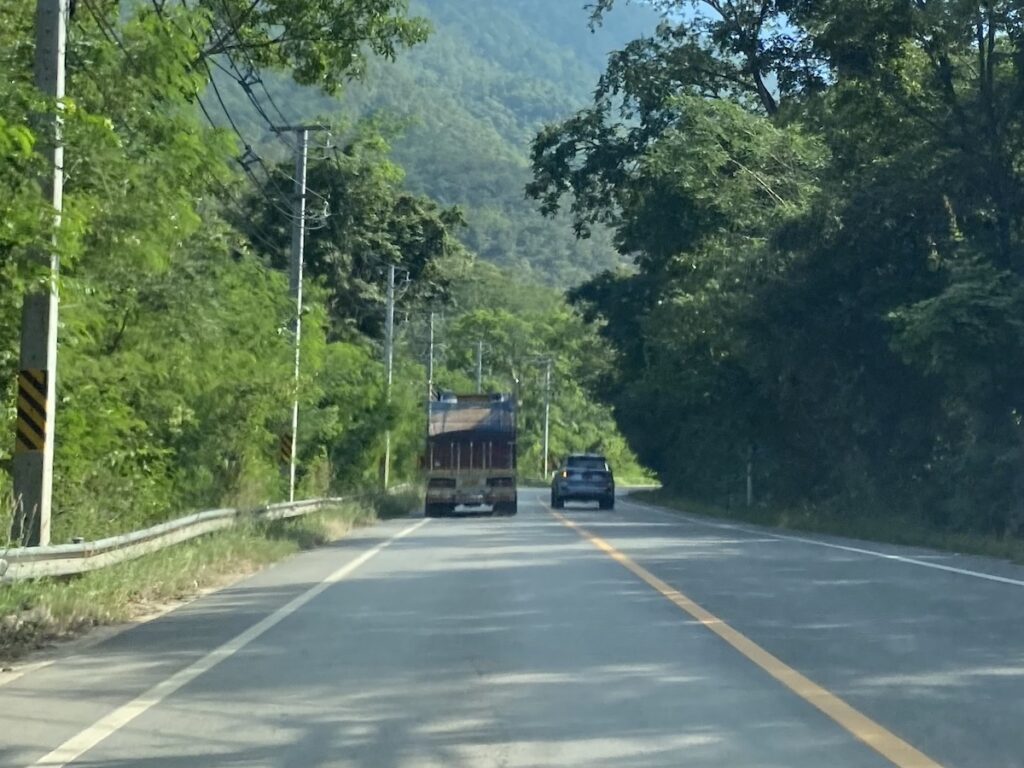
Is It Safe To Drive?
Is it safe to drive in Thailand, Vietnam or Laos?
Driving In Thailand
Despite the scary picture I might have painted above, Thailand is fine to drive in. The roads are excellent, well built and quite wide. The biggest issue is understanding the mindset… and the crazy speeds they drive!
We westerners tend to focus on what’s in front of us and what’s beside, around and behind us (in theory at least!). Thai drivers focus mostly on what’s in front of them.
It’s up to the following driver to keep an eye on the driver in front.
So drivers and especially motorbike riders tend to drive diagonally onto a road for example, without looking at what’s coming. Instead, it’s up to the approaching drivers to anticipate.
And they stop anywhere. They think nothing of stopping in a lane and double parking, blocking the entire lane. Following drivers simply go around them. No harm done.
And they wander across lanes, across the fog line, across the centre line. They wander at random, aimlessly.
Once you understand this, driving in Thailand becomes easier.
The only time we were truly uncomfortable was driving into Bangkok from the north. The freeway opens into four lanes a couple of hundred kilometres north of Bangkok. At the same time, masses of vehicles join from feeder roads.
And the speed limit increases! Great idea…
Until here, cars are limited to 90km/h and trucks to 60 (usually 70ish). But from here on, lanes 1 and 2 are 80km/h, lane 3 100km/h, and lane 4 an eye-watering 120km/h.
The Thais treat it like a racetrack.
The two left lanes are a continuous wall of trucks furiously tailgating each other. And they also use the third lane to overtake. They flick the truck out, like a slow-motion Formula 1 manoeuvre… no indicators, and no warning.
Meanwhile, cars are barrelling down the outside lane at 120, 130, or even 140km/h. When they get blocked, they start chicaning between the trucks.
Little wonder the road toll is so high.
Driving In Vietnam
Well, driving’s not even an option in Vietnam. Australians aren’t allowed to drive there. Even if it was, I wouldn’t.
By now, you might be scratching your head. “Why is Thailand okay to drive in, but has a massive road toll, yet Vietnam’s not?”
Well, Vietnam has a way higher population density than Thailand. So every road is heavily congested.
Imagine driving in the heaviest traffic you’ve ever driven in. Now take away all the road rules you’re familiar with and drive on the other side of the road. That’s what driving in Vietnam would be like.
Having said this, Vietnamese drivers are consistent and predictable… and patient. As a result, traffic tends to keep moving, even if it’s a snail’s pace at times.
Driving In Laos
We were going to hire a 4WD and drive in Laos for 2 weeks. But plans changed and we ended up driving in Thailand instead.
I’d drive in Laos. There’s not much traffic. But the biggest issue is the terrible state of their roads. It’s nothing to encounter a landslide, with more than half the road having slid 500 metres down a ravine.
In the mountains, you’ll regularly encounter large semi trailers broken down on the steep hills… often around blind corners and always on the road. With little infrastructure, the driver works on the truck on the road until he gets it going.
Slow and steady in Laos and you’ll be okay.
The Freedom Of Driving
After spending close to 7 weeks using taxis, private drivers, buses, trains, and planes, having the freedom of a car was absolutely brilliant.
We explored the incredibly beautiful rainforest jungle mountains of northern Thailand at our leisure. No time constraints, stopping where we wanted to, taking our time. Bliss!
If you’re an experienced and confident driver, driving in Thailand or Laos is definitely an option.
But do your research first. Spend time reading blogs about driving in each country… what to look out for, why they drive like they do, what the road signs mean, and so on.
If you don’t, you’ll be in for a rude shock!

Get your Traveller’s Guides
… and a whole lot more at our FREE RESOURCES Page!
Any questions or comments? Go to the Comments below or join us on Pinterest, Facebook or YouTube.
Any errors or omissions are mine alone.

